ML Aggarwal Class 8 Solutions for ICSE Maths Chapter 13 Understanding Quadrilaterals Check Your Progress
Question 1.
From the given diagram, find the value of x.
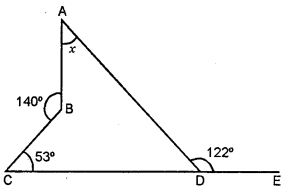
Solution:
Reflex angle B = 360 – 140 = 220°
Also, ∠ADC = 180 – 122 = 58° (Linear pair)
Now, ABCD is a quadrilateral
∴ ∠A + ∠B + ∠C + ∠D = 360°
⇒ x + 220 + 53 + 58 = 360
or x = 360 – 331 =29°
Question 2.
If two angles of a quadrilateral are 77° and 51°, and out of the remaining two angles, one angle is 10° smaller than the other, find these angles.
Solution:
Two angles of a quadrilateral are 77° and 51°
Sum of angles of a quadrilateral = 360°
∴ Sum of other two angles = 360° – (77° + 51°)
= 360° – 134° = 226°
Let one angle among there two angles = x
Then other angle = x – 10°
∴ x + x – 10 = 226°
⇒ 2x = 226° + 10° = 236°
⇒ x = \(\frac{236^{\circ}}{2}\) = 118°
∴ One angle = 118°
and other angle =118 – 10 = 108°
Question 3.
In the given figure, AB || DC, ∠A = 74° and ∠B : ∠C = 4 : 5. Find
(i) ∠D
(ii) ∠B
(iii) ∠C
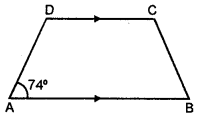
Solution:
∠A = 74° ∠B = 4x, ∠C = 5x.
As AB || CD
∴ 4x + 5x= 180°, 9x= 180°
⇒ x = 20°
∴ ∠B = 80° and ∠C = 100°
ABCD is a quadrilateral
∴ ∠A + ∠B + ∠C + ∠D = 360°
⇒ ∠D = 360° – (74° + 80° + 100°)
= 360°- 254 = 106°
Therefore, ∠D = 106° ∠B = 80°, ∠C = 100°
Question 4.
In quadrilateral ABCD, ∠A : ∠B : ∠C : ∠D = 3 : 4 : 6 : 7. Find all the angles of the quadrilateral. Hence, prove that AB and DC are parallel. Is BC also parallel to AD?
Solution:
Let, four angles of quadrilateral be 3x, 4x, 6x, 7x.
∴ 3x + 4x + 6x + 7x = 360
20x = 360 ⇒ x = 18

∴ ∠A = 3x = 3 × 18 = 54°
∠B = 4x = 4 × 18 = 72°
∠C = 6x = 6 × 18= 108°
∠D = 7x = 7 × 18= 126°
As, ∠A + ∠D = 54 + 126 = 180°
∴ AB || CD
(If two angles on the same side of transversal are supplementary,
then lines are parallel)
But ∠A + ∠B (54 + 72) ≠ 180
∴ BC is not parallel to AD.
Question 5.
One angle of a parallelogram is two-third of the other. Find the angles of the parallelogram.
Solution:
In a parallelogram, one angle is \(\frac{2}{3}\) of the other.
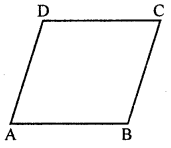
Let one angle = x
Then second = \(\frac{2}{3}\)x
But x + \(\frac{2}{3}\)x = 180°
⇒ \(\frac{5}{3}\) = 180°
⇒ x =\(\frac{180^{\circ} \times 3}{5}\) = 108°
∴ ∠A = x = 108°
∠B = \(\frac{2}{3}\)x = 108° × \(\frac{2}{3}\) =72°
But ∠C = ∠A and ∠D = ∠B
(Opposite angles of a parallelogram)
∴∠C = ∠A = 108° and ∠D = ∠B = 72°
Hence, ∠A = 108°, ∠B = 72°, ∠C = 108°, ∠D = 72°
Question 6.
In the given figure, ABCD is a kite. If ∠BCD = 52° and ∠ADB = 42°, find the values of x, y, and z.
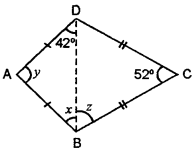
Solution:
Join BD.
In ∆ ABD,
AB = AD (Given)
∴ ∠ABD = ∠ADB
(angles opposite to equal sides are equal)
⇒ x = 42°
In ∆ BCD,
BC = CD (given)
∴ ∠BDC = ∠DBC = z
∴ z + z + 52 = 180° ⇒ 2z = 128
⇒ z = 64°
ABCD is quadrilateral
∴ ∠A + ∠B + ∠C + ∠D = 360°
⇒ y + (x + z) + 52 + (42 + z) = 360°
⇒ y + 106 + 52 + 106 = 360
⇒ y = 360 – 264 = 96°
Question 7.
In the given figure, ABCD is a rectangle. Prove that AC = BD.
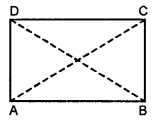
Solution:
In ∆ ABC and ∆ABD
BC = AD (opposite sides of rectangle)
∠B = ∠A (each 90°)
AB = AB (common)
∴ ∆ABC = ∆ABD (S.A.S.)
∴ AC ≅ BD (c.p.c.t.)
Question 8.
In the given figure, ABCD is a rhombus and EDC is an equilateral triangle. If ∠DAB = 48°, find
(i) ∠BEC
(ii) ∠DEB
(iii) ∠BFC
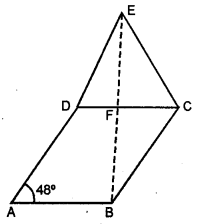
Solution:
ABCD is a rhombus
∴ AB = BC = CD = DA
Also, EDC is an equilateral ∆
∴ ED = DC = CE …(ii)
From (i) and (ii)
We get, BC = CE.
In ∆ BCE, ∠BCE = 60 + 48 = 108
Also, BC = EC
∴ ∠BEC = ∠EBC = x
⇒ x + x + ∠BCE = 180°
⇒ 2x = 180 – 108 = 72°
⇒ x = 36°
∴ ∠BEC = x = 36°.
(ii) ∠DEB = ∠DEC – ∠BEC
= 60° – 36° = 24°
(iii) In ∆ DEF,
∠D = 60°, ∠DEF = 24°, ∠DFE = y.
60 + 24 + 7 = 180°
y = 180 – 84 = 96°
∠BFC = ∠DFE = 96° (Vertically opposite angles)
Question 9.
Find the number of sides of a regular polygon if each of its interior angle is 168°.
Solution:
Each interior angle of a regular polygon = 168°
Let number of sides = n, then
\(\frac{2 n-4}{n}\) × 90° = 168°
\(\frac{2 n-4}{n}=\frac{168^{\circ}}{90^{\circ}}=\frac{28}{15}\)
∴ 30n – 60 = 28n
⇒ 30n – 28n = 60
⇒ 2n = 60
⇒ n = \(\frac{60}{2}\) = 30
∴ Number of sides of the polygon = 30
Question 10.
If the sum of interior angles of polygon is 3780° find the number of sides.
Solution:
Sum of interior angles of polygon = (2n – 4) × 90
∴ 3780 = (2n – 4) × 90 ⇒ (2n – 4) = \(\frac{3780}{90}\)
⇒ 2n – 4 = 42
⇒ 2n = 46
⇒ n = 23
Question 11.
The angles of a hexagon are (2x + 5)°, (3x – 5)°, (x + 40)°, (2x + 20)°, (2x + 25)° and (2x + 35)°. Find the value of x.
Solution:
Number of sides in hexagon = 6.
Sum of interior angles = (2 × 6 – 4) × 90 = 720°
∴ (2x + 5) + (3x – 5) + (x + 40) + (2x + 20)
+ (2x + 25) + (2x + 35) = 720
⇒ 12x + 120 = 720
⇒ 12x = 720 – 120
⇒ 12x = 600
⇒ x = 50.
Question 12.
Two angles of a polygon are right angles and every other angle is 120°. Find the number of sides of the polygon.
Solution:
Let the number of sides = n
∴ 2 × 90 + (n – 2) × 120 = (2n – 4) × 90
⇒ 180 + 120n – 240 = 180n – 360
⇒ 120n – 60 = 180n – 360
⇒ 60n = 300
⇒ n = 5
Question 13.
The sum of interior angles of a regular polygon is twice the sum of its exterior angles. Find the number of sides of the polygon.
Solution:
Sum of interior angles = (2n – 4) × 90
Sum of exterior angles = 360
According to the condition,
(2n – 4) × 90 = 2 × 360
⇒ 2n – 4 = 8
∴ n = 6
Question 14.
An exterior angle of a regular polygon is one- fourth of its interior angle. Find the number of sides in the polygon.
Solution:
Let measure of interior angle = x°
Then exterior angle = \(\frac{1}{4}\)x°
∴ x + \(\frac{1}{4}\)x = 180° ⇒ \(\frac{5}{4}\) x = 180
⇒ x = 180 × \(\frac{4}{5}\) ⇒ x = 144°
Therefore, each interior angle is 144°
\(144=\frac{(2 n-4)}{n} \times 90\)
⇒ 144n= 180n – 360
⇒ 180n – 144n = 360
⇒ 36n = 360
⇒ n = 10